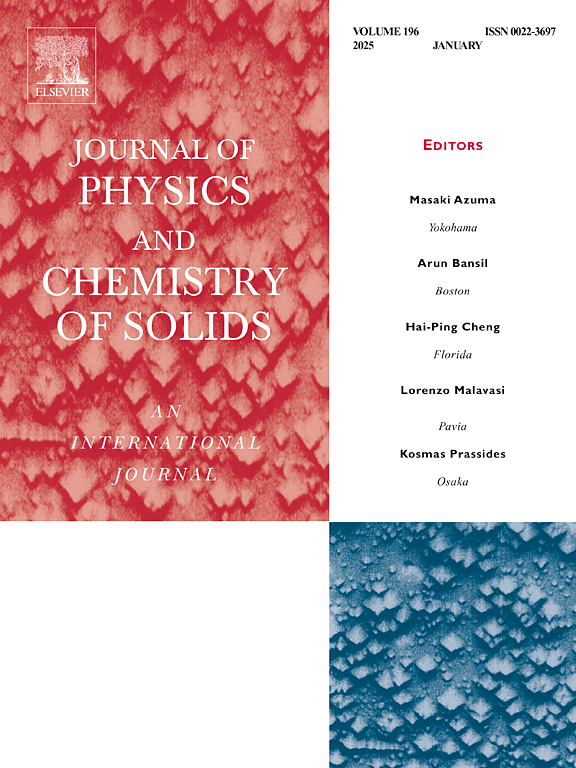19F high-resolution NMR studies on cation distribution and F− dynamics in highly conductive BaF2–CaF2 composite prepared by thermal plasma processing
IF 4.3
3区 材料科学
Q2 CHEMISTRY, MULTIDISCIPLINARY
引用次数: 0
Abstract
Mixing of immiscible BaF2 and CaF2 by mechanical milling or thermal plasma processing leads to a solid composite, whose ionic conductivity is much higher than those of BaF2 and CaF2. Distribution of Ba and Ca cations in the BaF2–CaF2 composite prepared by thermal plasma processing is examined by 19F NMR. Analysis of signal intensities of 19F high-resolution solid-state NMR shows that occupation ratios for the cations at four vertexes of a tetrahedron unit in a fluorite-type structure with one fluoride ion at its center are roughly given by binomial distribution. Further, 19F–19F dipolar correlation experiment shows that spatial distribution of both cations is random in a length scale of ca. 2 nm or less. These show that homogeneous mixing of vaporized BaF2 and CaF2 in thermal plasma is maintained in solids obtained by rapid cooling and leads to random distribution of both cations. Rearrangement of local configuration of both cations in a length scale less than a few nm occurs well below the decomposition temperature, which relaxes local strain associated with homogeneous mixing of different cations and lowers ionic conductivity. It is further shown that the fluoride ions in Ba-rich local environment are less mobile as compared to those in Ca-rich. The ionic conductivity evaluated using the fluoride-ion exchange rate estimated from 19F NMR spectra is consistent with the observed one, thus showing that exchange among the fluoride ions in different local environments is the fundamental step of the bulk ion conduction.

关于热等离子体加工制备的高导电性 BaF2-CaF2 复合材料中阳离子分布和 F- 动态的 19F 高分辨率 NMR 研究
通过机械研磨或热等离子处理将不相溶的 BaF2 和 CaF2 混合,可得到一种固体复合材料,其离子导电率远远高于 BaF2 和 CaF2 的离子导电率。通过 19F NMR 分析了热等离子处理制备的 BaF2-CaF2 复合材料中 Ba 和 Ca 阳离子的分布。对 19F 高分辨率固态核磁共振信号强度的分析表明,在以一个氟离子为中心的萤石型结构中,阳离子在四面体单元四个顶点的占据比大致呈二项分布。此外,19F-19F 双极性相关实验表明,在约 2 纳米或更小的长度范围内,两种阳离子的空间分布都是随机的。这表明在热等离子体中气化的 BaF2 和 CaF2 在快速冷却得到的固体中保持了均匀混合,并导致两种阳离子的随机分布。这两种阳离子的局部构型在长度尺度小于几纳米的范围内发生重排,远远低于分解温度,从而放松了与不同阳离子均匀混合相关的局部应变,降低了离子导电率。研究进一步表明,与富含 Ca 的环境相比,富含 Ba 的局部环境中氟离子的流动性较低。利用 19F NMR 光谱估算的氟离子交换率评估的离子传导性与观察到的离子传导性一致,从而表明不同局部环境中氟离子之间的交换是大量离子传导的基本步骤。
本文章由计算机程序翻译,如有差异,请以英文原文为准。
求助全文
约1分钟内获得全文
求助全文
来源期刊
CiteScore
7.80
自引率
2.50%
发文量
605
审稿时长
40 days
期刊介绍:
The Journal of Physics and Chemistry of Solids is a well-established international medium for publication of archival research in condensed matter and materials sciences. Areas of interest broadly include experimental and theoretical research on electronic, magnetic, spectroscopic and structural properties as well as the statistical mechanics and thermodynamics of materials. The focus is on gaining physical and chemical insight into the properties and potential applications of condensed matter systems.
Within the broad scope of the journal, beyond regular contributions, the editors have identified submissions in the following areas of physics and chemistry of solids to be of special current interest to the journal:
Low-dimensional systems
Exotic states of quantum electron matter including topological phases
Energy conversion and storage
Interfaces, nanoparticles and catalysts.

 求助内容:
求助内容: 应助结果提醒方式:
应助结果提醒方式:


